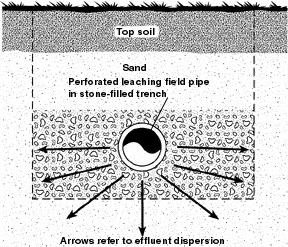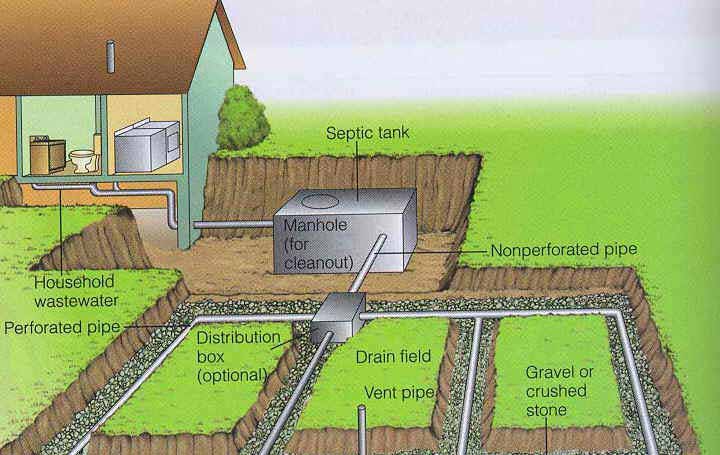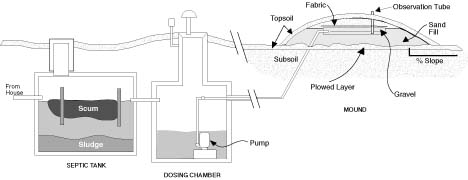If you're investing a large amount of money in a parcel of vacant land, there is one issue that may seem insignificant at first glance but could make or break a land deal.
The Perc Test
A Perc Test (also known as “Perk Test,” more formally known as a Percolation Test) is a soil evaluation that tests the rate at which water drains through the soil. The results of this test will provide crucial information needed to design and install a septic system, which is relevant for any property without access to a municipal sewer system.
A perc test is conducted by drilling or digging a hole in the ground, pouring water into it, and observing the rate at which the water is absorbed into the soil. In most cases, properties can easily pass a perc test when the soil has higher concentrations of sand (because sand tends to absorb water much faster than clay or silt) and when the property is situated in an area with a low water table.
Why Is a Perc Test Necessary?
For all intents and purposes, a perc test (and subsequently, a septic system) is only necessary when a property does NOT have access to a municipal sewer system.
If a vacant lot is within reach of an existing sewer hook-up, this will usually eliminate the need for a septic system. For this reason, the availability of an existing sewer system can be a big “perk” (no pun intended) when evaluating a property's suitability for building a dwelling of any kind.
When there isn't an existing sewer system nearby, that's when you'll need to explore the feasibility of a septic system. To determine whether a septic system is feasible, most county health departments require a perc test.
Most of the world's septic systems are designed in a way that requires a septic drain field or “leach field” to drain away any excess water. When solid waste settles in a septic tank, the excess wastewater is then discharged into the septic drain field through a network of perforated pipes.
Here's an example of what the typical septic system and drain field look like…
The contaminants expelled from this wastewater is then trapped and eliminated in the soil. This happens primarily 
The typical size of a drain field is determined by the expected volume of wastewater to be discharged from the septic system (which is usually estimated based on the size of the proposed building).
In order to understand the importance of a perc test, you also need to understand the basics of how a septic system works. This video provides a helpful explanation of how septic systems work and how a perc test fits into the overall scheme (skip to 3:42 to see the perc test explanation).
How to Do a Perc Test
In most jurisdictions, a perc test is performed when an official from the county health department meets with the owner of the property and/or a licensed excavator to dig a hole and test the drainage rate of the soil on-site (they literally pour water in a hole and time how long it takes to drain through).
The Health Department determines and enforces the rules governing whether a property is suitable for a septic system, so it's critical that they are present to perform and/or observe the test in real time.
Depending on the Health Department's requirements, the property's location, the building plans, and the soil composition, a perc test can be very simple and inexpensive or somewhat complicated and costly.
This video portrays what one of the more “complicated” versions of a perc test looks like…
As you can see, some situations call for heavy equipment, surveyors, engineers, and the like, whereas other situations can be as simple as drilling small holes in the ground (by hand) and taking samples of the soil. Again, the complexity of the process is largely determined by the Health Department's requirements, the property's location, the site plans, and the soil composition.
In my experience… I've found that, even though most county health departments follow the same general principles for a perc test, they handle certain aspects of the process quite differently. Just in the counties where I've worked, each one has had notably different standards in terms of:
- How much oversight is required?
- How much does the perc test cost?
- How rigorous are the requirements?
- What alternatives are allowed if the perc test fails?
Even though the same fundamental concepts apply almost everywhere, the specific procedures required in one county can be very different from the procedures of another, so it's important to be sure the test is being done in accordance with the rules and authorities in your area.
How Important is a Perc Test?
To answer this, you'll have to ask yourself a few questions:
1. What is my plan for the property?
People buy land for all kinds of reasons.
Some are looking for a place to hunt, farm, camp, and do other outdoor activities. If this is why you're buying land, then a perc test (for a septic system) probably doesn't need to be very high on your priority list.
Most people, however, buy vacant land because they intend to build something on it… and even if you don't intend to build anything, there's a fair chance that at some point in the future, the next buyer down the line will.
The importance of a perc test depends largely on whether or not a “dwelling” will ever be constructed on the property. If the answer is “Yes”, then it all boils down to this:
- Without a successful perc test, there can be no septic permit.
- Without a septic permit, there can be no septic system.
- Without a septic system, there can be no dwelling of any kind.
- If the owner can't build a dwelling of any kind, the property's value will diminish substantially.
Now, can a property still be usable/valuable without a septic system or dwelling on it? Of course! But in many cases, you'll still want to be fully informed about the property's “perc-ability” BEFORE you invest your life's savings into it. The last thing you want to do is make an investment decision based on false assumptions.
2. How much am I paying for the property?
Depending on the price you're paying for a property, it may or may not be worth the extra time and trouble of performing a perc test.
As a land investor, I've bought most of my properties free and clear from motivated sellers. The typical purchase price is $100 to $5,000, and when you're buying a property at this price, it's not always easy to justify the additional time, money, and hassle required to get a perc test.
Whenever I'm dealing with cheaper properties that don't necessarily need to be built on, I've usually skipped this step in the due diligence process. I've been able to get comfortable with this because there are several externally observable factors that have given me sufficient reason to believe the property had a high probability of passing a perc test (we'll cover more on this below).
In my opinion, if I'm buying a more expensive parcel of land (e.g., above $10,000), it's in the territory of “it's gonna hurt to be wrong,” so I usually take the time to verify before I proceed.
3. How big of a problem will it be if this property isn't buildable?
This one is pretty straightforward.
Whatever you plan to use this property for, whatever price you're thinking about paying, just think for a minute about the worst-case scenario.
What if you buy it, order a perc test, and it doesn't pass… then what? Does this property turn into a financial disaster, or is everything still okay?
If it's not a deal-breaker, it's probably okay to skip the perc test.
However, if the property's “buildability” is a significant contributing factor to its value (and it often is) and if it would be very bad to guess wrong on this, then why gamble? If you're planning to live on this property and/or resell it as a “buildable lot” in the future, order the perc test. The peace of mind can go a long way!
How Much Does a Perc Test Cost?
To do the job properly, a perc test will always cost something. Depending on who you hire and how much work is required, the price could range from $150 to $1,500 (and in my experience, it's usually at the lower end of that range).
That said, if you're just looking for a vague indication of whether the soil on a property will percolate properly, you don't necessarily need to spend $1,500. If you've got a shovel, a bucket of water, and you know what to look for, you can even do it yourself!
Of course, the only way to be 100% sure of a property's ability to percolate is to order a perc test under the local health department's oversight, since they will need to observe the test and issue final approval. That being said, if you're willing to tolerate some risk in the equation, there are other clues you can look for that will give you a halfway decent idea as to whether or not you need to worry about this.
For example, here are some easily observable factors to consider:
- Look at the other parcels adjoining your property. Are there any houses on these adjoining properties? If these parcels passed the perc test, there's a fair chance (though no guarantee) that yours can too.
- Are there any bodies of water nearby? If so, this property could have a high water table, wetlands, or be in or near a flood zone. These factors aren't always correlated with a property's ability to perc, but it may be a reason to use higher caution (and give you some other things to investigate) when deciding whether or not to spend the money on a perc test.
- What does the topography of your property look like? Is it up on a hill or down in a valley? Does it have a slope of any kind, with one end higher than the other? In some cases (when there is a high water table or varying soil types throughout a property), a vacant lot may not pass its perc test at the lower elevation, but it will pass at the higher elevation. For this reason, whenever I see a property that has a clear variance in elevation, I see this as a positive because it adds to the potential that even if the land won't perc on the lower end, it has another shot at passing on the higher end.
RELATED: What Is a Topographic Survey?
How to Order a Perc Test
If you're ready to hire a pro to evaluate your property, all you need to do is call your county health department (just Google the county name and then “Health Department” to find their phone number) and ask them what the requirements are to properly conduct a perc test.
In some counties, the health department will have to perform all of the work. In others, they will require a licensed excavator to do all the digging in advance.
Whatever the situation, remember that the rules and regulations can be very different depending on where your property is located, so before you take any big steps forward, make sure you learn how it's supposed to be done directly from the source. With the right information, you should be off and running in no time.
Who Pays for a Perc Test?
In most cases, the buyer will pay for the perc test as part of their due diligence before closing on the purchase.
Just as a buyer would pay for a survey, an appraisal, or any other assessment on the property, this cost would typically be paid by the buyer because they need to determine whether the soil is suitable for their intended use.
In some cases, the current property owner may have already performed the perc test and can simply show the buyer proof that the soil is suitable for the next step in obtaining septic approval. This kind of prior approval can add value to the property by providing some degree of certainty about how it can be used.
Of course, a buyer and seller can negotiate this cost however they see fit, but in most cases, the buyer would take the lead in covering it.
What If Your Land Fails the Perc Test? Try These Alternatives
If your property fails its perc test, don't panic. A failed perc test isn't the end of the story for any property.
Start asking some questions to determine what alternatives might be available…
- Check with the local Health Department about their records of any previous perc tests. Try to determine whether they searched the entire property for a proper septic drain field (in many cases, one section of the property may fail the test, while another section may pass with flying colors).
- Ask if it's possible to appeal the results of the previous perc test, and under what circumstances they would reconsider their original determination.
- Find out what time of year the failed perc test was performed. In many areas, the water table is higher during certain seasons and lower in others (e.g., winter vs. summer), which can influence soil drainage rates.
- If these first steps fail, it may be worth considering a modified septic system on the property. Some alternative septic systems can be reasonably priced (depending on the property's situation and the local requirements) and even environmentally friendly. These systems can be a bit more expensive than a conventional option, but they may give you more options to work with.
- Remember that soil types can vary across any parcel of land (and the lot's topography can also make a big difference). Be sure to tell your excavator to try a few places – you might be glad you did!
- Also, keep in mind that in some areas, if you wait long enough, the municipal water and sewer may become available. If your plan is to buy land and hold it for a while, it could still be worth your while.
It's also worth noting that when a property fails a perc test, it doesn't necessarily mean you can't build anything on it. In many cases, you can get around this issue by spending more on an engineered system and/or adding a raised sand bed to overcome the drainage issue (depending on what the Health Department is willing to allow).
And don't forget – there are all kinds of alternative uses for properties that don't even require a septic system. For example:
- Storage Units
- Pole Barns
- Horse Stable
- Grazing Fields
- Crops & Farming
- Orchard
- Camping
- Hunting
- Lumber
- Mining
- Drilling
Almost any property can be put to good use with a little creativity (and adherence to zoning requirements and mineral rights).
Images: wikipedia, co.thurston.wa.us, Ohio State University Extension











